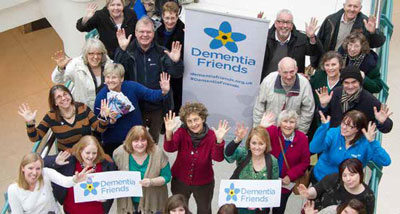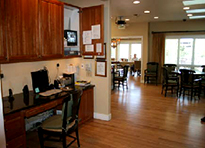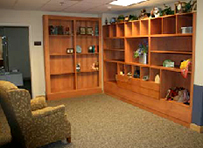All of us rely on environmental cues to support us physically, cognitively, and emotionally. This is even more important for a person experiencing the many cognitive, sensory, and physical changes associated with dementia. Unfamiliar, chaotic, or disorganized environments—whether at home, in adult daycare, or in a care facility—create stress and anxiety and contribute to behavioral problems.
A therapeutic environment recognizes that people with dementia are influenced by their surroundings and do better with environments that are individualized, flexible, and designed to support differing functional levels and approaches to care (Campernel & Brummett, Nd). At a minimum, an organization caring for people with dementia should understand that people with dementia do better in a setting that is designed to support their dignity and autonomy.
There is a trend toward designing facilities for people with dementia to be as homelike as possible. This idea was pioneered in Sweden in the 1980s. Today, similar concepts can be found all over the world, from Green Houses in the U.S. to group homes in Japan, small-scale living arrangements in the Netherlands, and German shared-housing arrangements (Gräske et al., 2015).
9.1 Philosophy of Care
An organization’s philosophy of care is a framework that identifies its goals and values. The family, and the person receiving services, has the right to know—and should feel free to question—a center’s philosophy of care. Key questions can include:
- Is the center’s philosophy consistent with your beliefs?
- Does the center provide services to persons at all stages of dementia?
- What conditions or behaviors determine whether a center will admit or retain someone with dementia?
- Is dementia care provided in a separate unit or as an integrated part of center’s services?
- Is the center’s philosophy and practice of handling "difficult behaviors" compatible with your views?
- What is the center’s philosophy in using physical restraints to deal with certain behaviors?
- Does the center recommend the use of psychoactive drugs to treat behaviors?
California Advocates for Nursing Home Reform, 2024
9.1.1 Dementia Friendly Care
Dementia friendly care focuses on the experience of people with dementia and advocates for positive attitudes and behaviors toward dementia. It treats people with dementia and their family and caregivers with dignity and respect and calls for an end to stigma. It seeks community support for people affected by dementia so they can “live well with dementia” (ADI, 2015).
Dementia Friends

Courtesy Alzheimer’s Disease International.
Dementia Friends is an international public awareness initiative delivered through volunteers and an online tool. Dementia Friends began in the United Kingdom and is run by Alzheimer's Society (Dementia Friends USA).
The Dementia Friends program, now available in the U.S., focuses on five key messages (Dementia Friends USA):
- Dementia is not a natural part of aging.
- Dementia is caused by diseases of the brain.
- It is not just about losing your memory.
- It’s possible to live well with dementia.
- There is more to the person than the dementia.
9.1.2 Person-Centered Care
Person-centered care relies on caregivers’ organization’s skills, training, and knowledge. It means that care is built around the needs and preferences of the client, the care professional, caregivers, and family members. It is the opposite of task-centered care. The goal is to create a high-quality, joyful, shared environment.
Person-centered care is flexible, creative, and supportive. It includes the person living with dementia and their family members and caregivers in care and treatment decisions, with the aim of increasing positive outcomes.
An innovative person-centered approach called “green care farms”, developed in the Netherlands, provides daycare services and 24-hour nursing home care to people with dementia. Green care farms offer a broad selection of activities—including caring for plants and animals. It encourages clients to engage in tasks suited to their level of dementia and physical capabilities (de Boer et al., 2019).
In a study of daycare services at green care farms, it was suggested people deliberately chose green care farms because of their dislike of the institutional environment of regular daycare facilities. Green care farms were perceived as more useful for clients, more meaningful, and providing more opportunities to be physically active and to go outdoors (de Boer et al., 2019).
9.2 The Physical Environment
There is a profound and direct connection between the environment and the way people feel and behave. Buildings thoughtfully designed for the care of people with dementia encourage community, maximize safety, support caregivers, cue specific behaviors and abilities, and redirect unwanted behaviors (Campernel & Brummett, Nd).
Certain design principles have been shown to reduce unwanted behaviors and enhance a sense of well-being in people with dementia. For example, getting rid of dark nooks and crannies, providing views to the outside, including private spaces and a separate room or recess for sleeping or resting, and having easily accessed public spaces and places for semi-private interactions support person-centered care and can reduce unwanted behaviors.
Additional design recommendations:
- Keep public spaces clean and get rid of odors.
- Replace institutional, centralized nursing stations with smaller, residential-looking stations.
- Create spaces to cue specific behaviors (activity kitchen, art and music therapy area, bistro/bar, rummaging room, library, coffee shop/internet café, quiet room, living room).
Living Spaces Designed for Dementia Patients


Left: Residential-looking, smaller-scaled nurses’ station. Right: a room for rummaging. Source: Campernel & Brummett, 2010. Used with permission.
For outdoor design (Rijnaard et al. 2016):
- Arrange outdoor spaces to resemble a natural community or yard.
- Create looping pathways with generous seating and areas of interest.
- Include clients in the design of new features.
- Create safe, purposeful, heated, and accessible outdoor areas.
- Offer attractive landscaping, gardens, and pleasing views.


Left: Safe, looping wandering paths with areas of interest along the way. Right: A memory-care facility with home-like outdoor porch area for seating and reflection. Source: Campernel & Brummett, 2010. Used with permission.
In a comparison of “regular” specialized care units and small, homelike specialized care units in the Netherlands, clients in the homelike care units needed less support with activities of daily life, were more socially engaged, showed less agitation over time, and needed less psychotropic medication and physical restraints. Residents of the small, homelike units awarded higher scores to aspects of quality of life, showed less negative affect and better social relationships, and were more engaged in activities (Kok et al., 2016).
9.3 Safety and Security
People with dementia need to feel safe (and be safe) without the use of physical and chemical restraints. Safety includes creating an appropriate environment as well as planning for adverse events, such as wandering away from the home or facility.
The table below illustrates some common safety hazards and measures to help make the environment more safe and secure. Since every situation is different, interventions must be tailored to match the specific circumstances.
Measures to Promote Safety and Security | ||
|---|---|---|
Safety issue | Possible consequence | Intervention |
Wandering | Getting lost, exposure to environmental hazards. | Use technology such as the Alzheimer Association’s Comfort Zone.* Provide short, looping corridors without dead ends. Create open, common areas of interest. Create safe, outdoor wandering areas that are accessible from indoor wandering paths. Paint the inner surfaces of doors so that they are not readily recognizable as an exit. Place locks where they are not visible. |
Cooking without supervision | Fire, injury | Install a shut-off valve on the stove. Remove burner on-off handles. Keep a working fire extinguisher. Create a work area with an activity kitchen. |
Falls | Injury | Rule out medical conditions. Create an uncluttered environment. Install handrails in showers and hallways. Install carpeting to reduce injuries. Wipe up spills promptly. Maintain physical activity. Supervise walking and use assistive devices. Remove throw rugs or tape edges down. Maintain good vision and hearing. Provide many places to sit. |
Poisoning | Sickness or death | Remove toxic plants from the environment. Lock up chemicals and medications. |
Simply receiving care at an adult daycare center can be a source of safety and security for a person with dementia. A well-designed and well-run facility is secure, comfortable, and predictable; it is a place where one can feel at ease—a place where you can be who you are and feel connected with like-minded people (Rijnaard et al., 2016). Adult daycare centers can also offer a sense of safety and security for caregivers, providing a feeling of shared responsibility and respite (Tretteteig et al., 2017).
9.4 Schedules and Routines
Schedules and routines are an important part of every person’s life and well-being. However, when someone enters a facility or participates in a daycare program, their usual routines are interrupted and altered. This can create tension between the necessary institutional routines and clients’ personal habits and needs (Rijnaard et al., 2016).
In traditional facilities providing services for older adults, schedules and routines are primarily organized around the convenience of the staff. As a result, schedules can change dramatically from day to day. This is difficult for people with dementia because they rely on a predictable routine for orientation. A regular routine allows a person with dementia to know what to expect and gives caregivers and family members a benchmark for evaluating any changes in a person’s behavior.
A schedule for someone with dementia should be planned carefully, allowing plenty of time for activities of daily living. Always keep in mind a person’s capabilities and preferences. Additionally:
- Maintain regular mealtime routines.
- Maintain regular dental and healthcare appointments.
- Note the effects of changes in routines.
- Address issues that disrupt routines such as pain, fatigue, or illness.
Caregivers responsible for maintaining a routine schedule must be flexible. People with dementia tend to be slow, so caregivers must allow ample time for meals and activities. Attempting to rush a person with dementia can lead to aggressive behaviors and frustrate both parties.
9.5 Staff as Part of the Environment
In Florida, adult daycare centers must employ qualified staff to provide the services, personal assistance, and safety measures required by participants. Nearly 60% of workers in adult daycare centers are aides, 18% are registered nurses, 11% are licensed practical nurses, and about 12% are social workers (Singh, 2022).
In centers providing adult daycare services, the following staff are required (O’Keeffe, 2014):
- A registered nurse or licensed practical nurse on site during the primary hours of program operation and on call during all hours the center is open. LPNs must be supervised by an RN.
- A social worker or case manager to provide and supervise social services, including counseling for families and caregivers and compilation of a social history and psychosocial assessment of formal and informal support systems, and mental and emotional status.
- An activities director or recreation therapist, who may be retained as a consultant. Services provided by program aides must be directly supervised by the activity director or recreation therapist.
9.5.1 Proper Staffing
The importance of having sufficient, competent staff is a major concern in many countries. High turnover and difficulties recruiting qualified staff are common challenges. Several significant factors can impact job satisfaction and the ability to provide quality care. These include unclear roles and functions, heavy workloads, demanding work schedules, difficult ethical issues, job strain, stress, and burnout (Vassbø et al., 2019).
Dissatisfaction with work can result in lower loyalty to the workplace and an increased probability of leaving. Research indicates that those who are dissatisfied with their working conditions have an increased tendency to avoid work responsibilities through absence, purposely avoiding activities, taking shortcuts, or making themselves unavailable when actions are required (Vassbø et al., 2019).
A person-centered approach can decrease staff turnover, improve worker satisfaction, and reduce clients’ unwanted behaviors. This is important for people who work in care facilities as well as the clients they are serving. A person-centered approach includes establishing shared goals, sharing professional values, and being part of a supportive team (Vassbø et al., 2019).
9.5.2 Staff Adjusting to Resident Routines
In adult daycare settings, clients are ideally cared for by a small, fixed team of trained caregivers. Activities, rest periods, and meals should be organized completely, or in large part around each client’s needs and routines. To encourage this practice, a facility must hire and train staff with the emotional skills to interact with people with memory problems.
Experienced staff understand that a client may have a favorite chair, a preferred location during mealtimes, and food and rest preferences. A client may have differing needs with regards to heating and cooling, blankets or no blankets, styles and type of music, preferred activities, and preferred friends. Consistency and communication keep staff members aware of client preferences and allow them to adjust to a client’s needs and routines.
